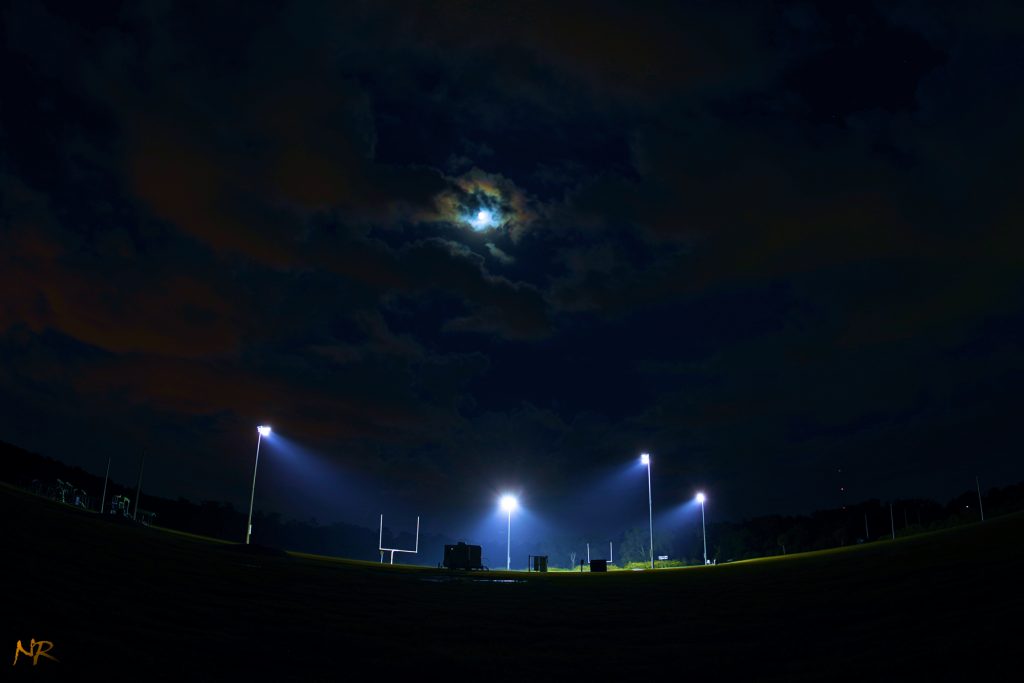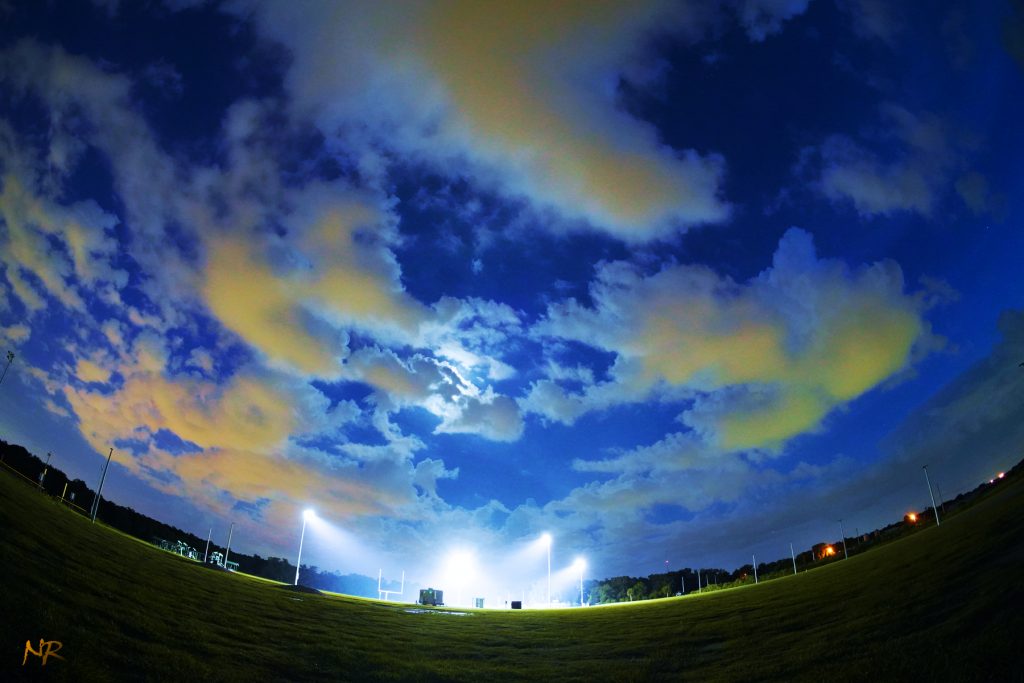Last night, the sun had gone down and the night sky was taking shape.
There was no lightning in the area but just in case all the weather maps were wrong, I hopped in the car and drove the short ride to the ball fields.
I set up the camera and pointed it at the only part of the sky that there might possibly be some action and waited.
There were a couple of teenie flashes 30 to 40 miles away but nothing I could catch. All was quiet where I was.
Typical. The one time I want the weather app to be wrong and they’re right.
I stood there for a while and the only thing I was getting was getting bitten by mosquitoes. I had sprayed myself on face, head and arms but their nasty little selves decided to bite me on the back through my shirt.
Anyway I wasn’t far away from calling it a night when I noticed that the practice field in the distance still had its lights on and presented a cool contrast to the darkness around it.
Right above it, the moon was trying to find a way through some random clouds.
I took three pics and added them below this little blog. The first is very close to what my eyes were seeing. The second was just me playing with some manual settings like exposure time and aperture and the third was the same but using a very high ISO setting.
I hope you enjoy!
Anyway, the thought that came to me after I saw the differences was how the very same scene can be perceived in dramatically different ways just by a few small changes on a camera.
But when I stand there and look at something and you stand beside me, do we see the same thing?
What if your eye settings are slightly different to mind. What if your perception of blue is my perception of violet? I mean they don’t have to be startlingly different, just enough to make our experience not quite the same.
That thought has plagued my mind ever since I first picked up a camera and I have extended the thought beyond us humans to where I wonder if a bird sees the sky as blue or a frog see the lily pad as green.
Everything we see is defined by shape and color. But if our perception of color is slightly off or just different from others, are we really seeing what we are seeing?
Bees for example see in a lower and more narrow spectrum to ours, so while they are impervious to reds, they can see UV light that is entirely beyond our ability to see.
And spiders don’t just see better than us in high definition, they too can see UV light we can’t.
And what about my beloved cats? Their vision may be a little blurrier than ours and not able to focus on things that are beyond 20 feet, but they have a wider view in peripheral vision than we do and of course they have receptors that allow them to see in the dark.
Even our perception of shape differs. Not so much between humans but between humans and other creatures. The obvious one that we all know is the fish-eye view. Where the lens in the eye is so wide that it distorts a straight line into a curve. Or are we distorting a curve into a straight line?
So lets return to the bees. They have five eyes and form shapes based on an input that is far different to the stereo view we get.
Not to mention spiders who typically have eight but some have as many as twelve eyes. Imagine how their composite view of something differs from ours.
So the very things we see and define by color and shape are actually so subjective to us because we only have two eyes and only see in a set range of colors.
That makes the “I saw it with my own eyes” statement far less factual than you might imagine.
Because even back in the land of us humans, our perspective is likely different enough to where you can have two people see the same thing and describe it differently. Try getting five people to agree with an exact definition of who they saw running away from a crime scene.
And even if we were to agree physically with what we have seen, our interpretation can be wildly different. Try getting a republican and a democrat to listen to the same incitement speech and come back with explanations that match.
Yet still somehow, us humans seek to define things in absolute terms. Battles rage between good and evil, black and white, right and wrong.
We look to define where the act of definition itself is a flawed concept.
We write laws as if each situation or each person is living the same life and should behave in the same way.
We make statements and give commands as if an instruction can be absolute and agreed upon. Does the person on the other end hear and understand the command exactly as it formed in your mind when you issued it? Highly unlikely.
Try asking your kid to take out the trash only to find several hours later that it still wasn’t taken out. “I was just about to”
You forgot to say the word now.
“Take out the trash now” and ten minutes later it still isn’t. “i was just finishing the end of this movie. It’s almost over.”
Even when we try to narrow the possible ways a command can be interpreted, it is received through their filter, not yours.
The word “now” may mean one thing to you but I can guarantee you it means something entirely different to a sixteen year old boy watching a movie on his laptop.
Just this past week I asked a friend a specific question about whether we were meeting or not, what time, and where. Her response in text was “Let me think, Give me a few”
The following day I still didn’t have an answer so when I heard “few” I assumed minutes but maybe in her mind it was days.
Anyway, the point to all this ramble is that though we can try as much as we want to define life in narrow and absolute ways, it cannot be so defined.
Life is not black and white. It isn’t even shades of grey. It is a broad spectrum of colors, some of which we can’t even see.
So when we hear a viewpoint that is not our own, we need to hear it. We don’t necessarily need to agree with it, but we need to at least understand that it is based on a perspective that is real to the person offering it.
… just a thought!




